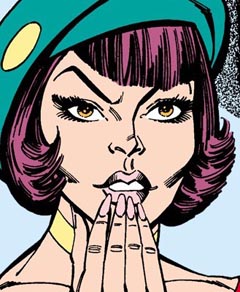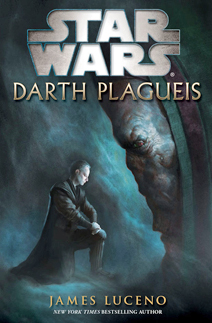“Darth Plagueis” (January, hardcover) is arguably the most hyped-up “Star Wars” novel since 1996’s “Shadows of the Empire,” with the ForceCast (which plans an upcoming “Darth Plagueis” roundtable episode) calling it a “game changer” and Entertainment Weekly — which normally doesn’t cover “Star Wars” novels with much depth — posting an excerpt.
Buying into the hype, I went ahead and purchased the novel rather than waiting for it to come in at the library.
So a note of caution to “Star Wars” fans: Although “Darth Plagueis” is a great read (as was to be expected, with James Luceno penning it), I can’t say I was really surprised by anything that happened in the novel. In short: Definitely read “Darth Plagueis,” but don’t feel like you have to read it immediately lest you fall behind the curve in “Star Wars” knowledge.
That having been said … SPOILER WARNING: If you haven’t read the book yet, you’ll want to stop reading this review here.
The pleasure of “Darth Plagueis,” as with so many of Luceno’s novels, is that we spend time with and get into the heads of characters from the movies (“Dark Lord: The Rise of Darth Vader” is another example of this). Here, we get to know Plagueis, who aims to control midi-chlorians so he’ll have power over life and death. He also aims to end the Rule of Two by taking on Palpatine, a.k.a. Darth Sidious, as more of a partner than an apprentice. His thinking is that Palpatine, being human, will have the best chance to be elected Supreme Chancellor. But Plagueis, being a Munn, could then be appointed co-chancellor, and they would rule together.
We also get the full Sidious backstory: How he grows up among Naboo’s wealthy elite and gradually gets in touch with his political ambitions and his dark-side powers. We also learn how Sidious finds Darth Maul and trains him to become his own apprentice.
Plagueis, Sidious and Maul are the three main Darths that Luceno delves into, but the embarrassment of story riches continues, because we also get the early meetings between Darth Sidious and disgruntled Jedi Master Dooku, who will of course become Darth Tyranus, Sidious’ second apprentice in “Episode II: Attack of the Clones.”
If you look at “Star Wars” fiction as one giant puzzle, then “Darth Plagueis” is a key piece — story points snap into place throughout the novel.
One problem I had with the book might be more my own problem than Luceno’s. There’s a lot of talk about how Hego Damask (Plagueis’ real name) and Palpatine maneuver political and economic players around the galactic game board. “Taxation of trade routs,” that much-maligned plot point from the opening crawl of “Episode I: The Phantom Menace,” is front and center, and I had trouble following the details, although Luceno certainly nails the personality of the Trade Federation’s Neimoidian leader Nute Gunray.
And not all the Big Questions are answered. Although we see that Plagueis loves experimenting with midi-chlorians, we don’t see him achieve any grand success. I was fully expecting that either Plagueis or Sidious would create Anakin in Shmi’s womb out of midi-chlorians, but this scene never takes place. I think we are led to fall back on the spiritual theory that the Force created Anakin, which is fine — in fact, I like that development a lot — but I’m surprised that this plot point wasn’t directly addressed, especially since Luceno often breaks free from following his two main characters and provides wider historical context.

Other missed opportunities (or opportunities for future stories): I thought perhaps we’d learn how Darth Sidious brings Darth Maul back to life after his death at the blade of Obi-Wan in the Theed complex. The good news is that we might get that very story later this season on “The Clone Wars”: It’s already been confirmed that Maul will appear in the final Season 4 arc.
Considering that Sidious resurrects Maul, courts Anakin to the dark side with his teases about cheating death, and indeed does cheat death in the “Dark Empire” comics, I thought we’d see Sidious gain this skill in “Darth Plagueis.” But Plagueis — despite some successes with dark experiments on an isolated island — doesn’t have his eureka moment; Sidious kills him first. And we aren’t even given a hint as to how Sidious acquires his death-cheating knowledge; in fact, Sidious seems slightly repulsed by Plagueis’ experiments.
Furthermore, Sidious shows no disgust at having to work with numerous non-humans — particularly his own Sith Lord! — as he engineers his rise to power. We know that Palpatine’s Empire, in stark contrast to the Republic he inherits, includes primarily humans because Palpatine is species-ist. So it’s odd that this point goes unaddressed.
As it stands, “Darth Plagueis” is still a solid (indeed, essential) character piece for Plagueis and Sidious. It’s tempting to find the good side of evil characters when they are the protagonists (see Drew Karpyshyn’s Darth Bane novels), but Luceno resists that easy path. Plagueis and Sidious are undeniably bad guys throughout the novel, yet it is not unappealing to read about them. Honestly, I was intrigued by the two Darths’ ends-justifies-the-means outlook on the galaxy. Not swayed, necessarily, but I could see why this philosophy appealed to them.
It also should be noted — in light of “The Clone Wars” occasionally playing fast and loose with continuity — that “Darth Plagueis” is entirely respectful of the stories that already exist. Because this book covers a long time period (Sidious’ entire life up through “The Phantom Menace”), two entire novels take place within the timeframe of this novel. It makes me want to re-read Luceno’s “Cloak of Deception” and Michael Reeves’ “Darth Maul: Shadow Hunter,” both published in 2001 in the wake of the first prequel.
Luceno also ties in Maul’s backstory, hinted at in the “Nightsisters” trilogy from “Clone Wars” Season 3, and name-drops many other characters we’ve gotten to know in “The Clone Wars,” and some from the novels, including Reeves’ and Timothy Zahn’s.
Throughout the last couple seasons of “The Clone Wars,” I’ve lamented that we haven’t seen any new “Clone Wars” novels or comics (other than kid-centric one-shot comics), but “Darth Plagueis” very much feels like it takes place in the “Clone Wars” universe. This is a credit to the fact that Lucasfilm took more of a direct interest in this novel than it usually does, and that the publishers checked in with “Clone Wars” producer Dave Filoni to see what he had planned for Maul.
So: Game-changer? Not necessarily. To paraphrase Dennis Green, Darth Plagueis and Darth Sidious are who I thought they were. But, great read? Definitely.

